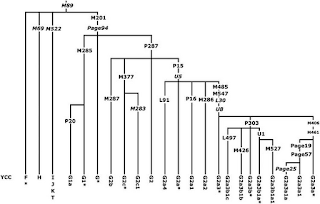Main » 2013 » January » 26 » Major new paper on Y chromosome haplogroup G (Rootsi et al. 2012)
14:40 Major new paper on Y chromosome haplogroup G (Rootsi et al. 2012) | |
Haplogroup G is of substantial interest to prehistorians, because it has
been sampled on multiple Neolithic locations from across Europe. A new
paper updates the phylogeny of this important haplogroup (left), and
studies its distribution. You can find information about the frequency
of different haplogroup G subclades in the freely available supplementary material (Table 1).
From the paper: First, we calculated haplogroup diversity using data in Supplementary Table S1 for the 52 instances when total population sample size exceeded 50 individuals and Z5 hg G chromosomes were observed. Then we applied a 10% overall hg G frequency threshold and the additional specification that both haplogroup G1 and G2 lineages also be present. In the ten remaining populations, haplogroup diversity spanned from a low of 0.21 in Adyghes, to highs of 0.88 in Azeris (Iran) and 0.89 in eastern Anatolia and 0.90 in Armenia. We estimate that the geographic origin of hg G plausibly locates somewhere nearby eastern Anatolia, Armenia or western Iran. The general frequency pattern of hg G overall (Figure 2a) shows that the spread of hg G extends over an area from southern Europe to the Near/Middle East and the Caucasus, but then decreases rapidly toward southern and Central Asia.
It is certainly interesting that the estimated region of origin of haplogroup G intersects my so-called "womb of nations", out of which I believe flowed populations after the inception of the Neolithic. The rapid diminution of this haplogroup in Central/South Asia may be compatible with the relative lack of the K=7 "Southern" autosomal component in populations of the area, in contrast to a couple of Neolithic European farmers (the Tyrolean Iceman and Gok4). The Iceman himself belonged to haplogroup G, and so did individuals from Derenburg LBK, and Treilles.
A couple of lineages of interest are M527 which is a low-frequency haplogroup which the authors associate with Greek colonization and the Sea Peoples, and L497 which they associate with the LBK. It would certainly be interesting to test for the latter in some of the existing ancient DNA samples. Finally, the following is of interest: Concerning the presence of hg G in the Caucasus, one of its distinguishing features is lower haplogroup diversity in numerous populations (Supplementary Table S1) compared with Anatolia and Armenia, implying that hg G is intrusive in the Caucasus rather than autochthonous. Another notable feature is its uneven distribution. Hg G is very frequent in NW Caucasus and South Caucasus, covering about 45% of the paternal lineages in both regions2 in this study. Conversely, hg G is present in Northeast Caucasus only at an average frequency of 5% (range 0–19%). Interestingly, the decrease of hg G frequency towards the eastern European populations inhabiting the area adjacent to NW Caucasus, such as southern Russians and Ukrainians,18,40 is very rapid and the borderline very sharp, indicating that gene flow from the Caucasus in the northern direction has been negligible.Unfortunately, we currently lack ancient Y-DNA samples from West Asia. But, certainly, the samples we do have from Europe are indicative of shifts in West Asia as well, since the predominance of Y-haplogroup G in Neolithic Europe is hardly compatible with a haplogroup composition in the eastern source areas similar to today's. Rather, it begins to appear that there once was a (roughly speaking) western-eastern-southern distribution of the G/R1/J2 lineages in the territory of West Asia; this would be compatible with both the Neolithic European G dominance, the paucity of G in Central/South Asia, and its NW/S vs. NE Caucasus differentiation. European Journal of Human Genetics advance online publication 16 May 2012; doi: 10.1038/ejhg.2012.86 Distinguishing the co-ancestries of haplogroup G Y-chromosomes in the populations of Europe and the Caucasus Siiri Rootsi et al. Haplogroup G, together with J2 clades, has been associated with the spread of agriculture, especially in the European context. However, interpretations based on simple haplogroup frequency clines do not recognize underlying patterns of genetic diversification. Although progress has been recently made in resolving the haplogroup G phylogeny, a comprehensive survey of the geographic distribution patterns of the significant sub-clades of this haplogroup has not been conducted yet. Here we present the haplogroup frequency distribution and STR variation of 16 informative G sub-clades by evaluating 1472 haplogroup G chromosomes belonging to 98 populations ranging from Europe to Pakistan. Although no basal G-M201* chromosomes were detected in our data set, the homeland of this haplogroup has been estimated to be somewhere nearby eastern Anatolia, Armenia or western Iran, the only areas characterized by the co-presence of deep basal branches as well as the occurrence of high sub-haplogroup diversity. The P303 SNP defines the most frequent and widespread G sub-haplogroup. However, its sub-clades have more localized distribution with the U1-defined branch largely restricted to Near/Middle Eastern and the Caucasus, whereas L497 lineages essentially occur in Europe where they likely originated. In contrast, the only U1 representative in Europe is the G-M527 lineage whose distribution pattern is consistent with regions of Greek colonization. No clinal patterns were detected suggesting that the distributions are rather indicative of isolation by distance and demographic complexities. | |
|
| |
| Total comments: 0 | |
мэдээний ангилал
| aрхеологи [24] |
| антропологи [4] |
| түүх [12] |
| эрдэм шинжилгээний бүтээл [12] |
| монголын археологичид [1] |
| монгол угсаатан [4] |
| түүх соёлын дурсгалт газар [3] |
| мэдээлэл [6] |
| ярилцлага, нийтлэл [9] |
| хэрэгцээтэй зүйлүүд татах [11] |


